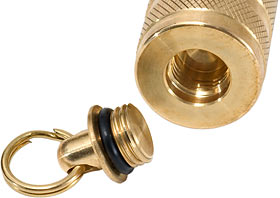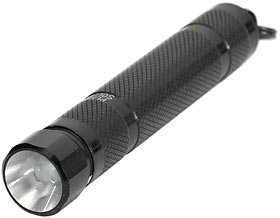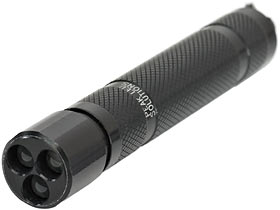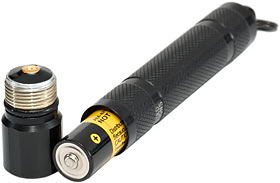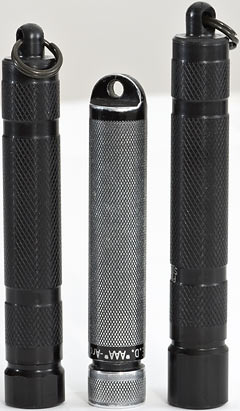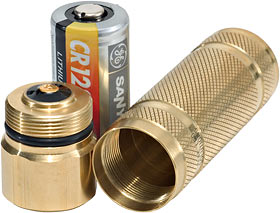
Peak LED Solutions pocket flashlights
Review date: 12 November 2004.Last modified 03-Dec-2011.
Great was the lamentation among persons unhealthily obsessed with portable lighting devices when, recently, Arc Flashlight went broke.
(Arc got better a while later.)
Arc were hardly a household name in the flashlight business, but I was very impressed with the various Arc products I reviewed. They're rock solid, well engineered and, of course, bright.
But if you want 'em now, you've got to fish around on eBay and, probably, pay quite a bit more than the old retail price. This is, of course, annoying. And particularly annoying to me, since it means I have trouble deciding whether to talk about Arc products in the past or present tense. Expect inconsistency in this review.
It's still possible to find an Arc-LS on eBay for a non-ridiculous price, if you're patient; Arc-AAA prices are being pumped up more, for some reason. But if you're sensible, you'd rather buy much the same sort of flashlight from somewhere else.
Peak LED Solutions is an outfit which, I'm told, has a close family connection to the company that actually fabricated almost all of Arc's lights, and which apparently had a bit of a messy relationship with them. Peak have been quietly building a line of modular LED lights with the same basic philosophy as Arc's, but some very interesting innovations of their own.
I am, for instance, not kidding about that "modular" part. If these things had legs, they'd be Micronauts. Or maybe Modulok.
Peak make, you see, lights that use single AAA and AA cells. And three kinds of light that use little N cells. And another three kinds that use lithium CR123 cells. Each of these basic classes of light can be had with at least two choices of lamp, with different numbers of LEDs. Often, there are three lamp choices. And then you can choose from at least two kinds of metal for the light to be made out of - black hard anodised aluminium, or uncoated brass. And sometimes there's a third metal choice - stainless steel - though the third metal choice constrains the lamps available.
And THEN you can choose a "Standard" or brighter, lower battery life "Hi-Power" version.
And THEN you can, often, pick a plain "pocket" version, or a "keychain" one with a split ring mounted to the end of it.
If I'm counting the flashlights on their products page correctly, this means that even if you don't take the lamp brightness choice into account, Peak have forty-five distinct models of flashlight.
But wait, there's more.
Each lamp type can be had in several LED colours. White, "snow" (a purer, smoother, less blue white than most LED flashlights offer), red, UV, amber, green, cyan, blue, pinkish purple or RGB cycling. And because a couple of the classes of Peak light are double ended - two flashlights joined together tail to tail, that don't share the same batteries - you can choose more than one lamp kind for a single light.
Take every variable into account and, according to Peak, there are over 1700 possibilities. If that isn't enough for you, they do custom work too.
In the face of this bewildering array of different lights, I just asked them to send me a few of their own choosing. And this is what I got.
Little lights
All of Peak's current lights are named after mountains. Mountain Peaks, geddit. The ones on the left and the right in the above picture are both single-AAA-cell "Matterhorns"; one with an Arc-AAA-style single LED and reflector, and the other with Peak's innovative three-LED head. They're both made from anodised aluminium.
The fatter, fancier light in the middle is a "McKinley", running from a single CR123 lithium cell (the same as the excellent Arc-LS), but equipped with a seven-LED shrouded lamp, not the single Luxeon LED that's more usual for lights like this these days. Not that there are many lights like this, mind you.
All three of the lights I got for review have "snow" white LEDs, and all three are the "Hi-Power" versions that throw more light, suck more juice and cost a bit more than the "Standard" editions.
All three lights also have a keyring attachment on the end. But that is, unsurprisingly, another modular component...
...which you can simply unscrew if you like, revealing a little O-ring-sealed cavity in which you could conceivably store a small object.
More practically, this feature means it'd be easy to remove the light from a keyring. The threaded hole in the end (which I think uses a 9mm coarse thread, but I could be wrong) can also be used to attach the lights to something. Peak sell three different flexible stalk widgets with clamps and magnets.
They also sell separate lamps and bodies in all shapes and sizes (including a two-AA-cell one, not available as a one-item flashlight), just in case there wasn't enough choice already. The separate lamps are expensive enough that you really might as well buy them as part of another whole flashlight, though, unless you're being shot into space and want to take two colours of flashlight with you at the minimum possible weight cost.
For all this fanciness, the flashlights themselves aren't expensive at all - at least, not by the all-metal, rock-solid, secret-agent-gear standards to which they should be held. The Hi-Power Matterhorns I got sell for $US29.95 for the 1-LED one and $US34.95 for the 3-LED one. The 7-LED McKinley is $US44.95. This puts the smaller lights on par with the old regular-model Arc-AAAs; the bigger one's much cheaper than the Luxeon-lamped Arc-LS used to be.
(All of Peak's prices are reduced by 10% if you're a member of the US military, by the way.)
So that's all great. But are they any good?
Inside and out
As far as basic features go, the single-LED Matterhorn is, indeed, pretty much exactly the same thing as an Arc-AAA.
Both have one 5mm LED with a silvery reflector around it. The reflector doesn't do much for the total light output, but does increase the light's "spill", the dimmer circle of light around the main beam. Spill is good if you want to see where you're going, but bad if there are people nearby who'd like to kill you. It's your call.
Both lights are also O-ring sealed to keep out water, and feature a hard anodised finish (though not on the brass and steel Matterhorns) and, of necessity, step up the 1.5 nominal volts from their single AAA cells to drive the 3.6-volt-ish white LEDs.
The Matterhorns also, like all of Peak's other regular-production lights so far, use the same simple switch mechanism as the Arc-AAA. You tighten the lamp end down to turn them on, and loosen it to turn them off. Unscrew it completely to get at the battery compartment.
The Arc-AAA and Matterhorn are actually so similar that their lamps are interchangeable. There are a few points of difference, though.
The Matterhorn's lamp surround is a bit oversized and has twelve flats on it, which mildly discourage the light from rolling away on a gentle slope. The Arc has a round lamp.
The contact on the back of the Matterhorn lamp, for the positive end of the battery, is a little metal button (which has "H" stamped into it to indicate a Hi-Power lamp, by the way). The Arc-AAA lamp contacts are solder blobs, which get dented and dirty over time and may need to be re-formed with a brief kiss from a soldering iron. A bit of fine abrasive paper, or just a pen eraser, should do the same trick for the Matterhorn's contact, if it's ever necessary at all.
The Matterhorns and the Arc-AAA both use a little foam rubber washer to stop their AAA cell from rattling (that'd be another minus for users who have people-wanting-to-kill-them problems), but the Matterhorn washer is at the bottom of the battery compartment, around the negative contact. The Arc's washer was stuck to the back of its lamp, which was all very well until you used some lubricant on the lamp threads that ate the glue, the washer or both, whereupon you'd have a loose scungy washer floating around inside the light unless you ripped it out altogether and, optionally, asked Arc for a new one.
You have to grease the lamp threads now and then, because the constant twisting this sort of switch requires will otherwise damage them. The threads on the 1-LED Matterhorn I got felt a bit rough, but a dab of grease cured that; the 3-LED Matterhorn was smooth, and the brass McKinley was very smooth.
The three-LED Matterhorn is an impressive achievement. People have managed to shoehorn Luxeon LEDs and the recent "super-LEDs" from other manufacturers into lights this small, but there's no way to get a AAA alkaline cell to drive even a basic one watt super-LED at anything like its full power. Even "premium" AAAs (PDF datasheet here) start screaming for mercy at a few hundred milliamps; half a watt is a lot to ask from one of them.
For this reason, hacked-together big-lamped tiny-lights often run from rechargeable cells, which can deliver a lot more current without complaint but have less capacity.
5mm LEDs like the ones used in all of the Peak lights to date, though, have a rated power of a tenth of a watt, at most; usually quite a bit less. Three of them should run quite happily from a single AAA driving a step-up DC-to-DC converter, and such is indeed the case with the three-LED Matterhorn.
Peak claim the Hi-Power single-LED Matterhorn will give you eight hours of run time before it sags to half of its original brightness (the non-Hi-Power version gets ten hours); they say the 3-LED Hi-Power will manage three hours (four, for the standard version).
Interestingly, the 3-LED lights have almost as much total run time as the 1-LED ones - 10 hours versus 12 - presumably because the LEDs get more efficient as you feed them less power, and three LEDs can therefore make better use of a mostly dead battery than one. The 3-LED lamp starts out this way, too; it doesn't drain the battery much more than twice as fast as the 1-LED one because it's not running its LEDs at anything like three times the power of the 1-LED's single one.
It also takes, according to Peak, seven hours before the 3-LED lamp drops to half of the original brightness of the 1-LED lamp.
This, for those of you who've been patiently waiting for an executive summary, all means that the 3-LED Matterhorn light looks like a much better thought out product than a lot of little-battery, big-lamp flashlights.
This is the 3-LED light open; the 1-LED one looks much the same. Yes, you get a battery with the light. Note the black resin seal around the end of the lamp, and the little contact button. This is a much nicer looking lamp-back than Arc made.
1-LED on the left, 3-LED on the right, well-worn Arc-AAA in the middle. The keyring end-piece on both Matterhorns makes them enough longer that they're noticeably less "pocketable"; the 1-LED model's about 82.5mm long when it's turned off (a tad shorter when the lamp's screwed down to turn it on), and the 3-LED version is about 87.5mm, versus 71.5mm for the Arc.
You can unscrew the end plug from the Matterhorns, of course, or buy the plugless versions, which are shorter again. But if you want a really Arc-y light, Peak's original "prototype" AAA-cell light bodies looked very like an Arc-AAA. You'll be able to buy them again soon, apparently.
On to the show pony.
Brass is really not a very sensible material out of which to make a flashlight. It'll tarnish, it'll make your hand smell coppery, and it's heavy. With a battery, the brass McKinley light weighs about 95 grams (3.4 ounces), versus only about 62 grams (2.2 ounces) for my old Arc-LS, which is brighter and has a clicky tailcap switch.
But hey, maybe you like the idea of a little flashlight with some satisfying weight to it. And brass has style, baby. And you don't have to pay any more to get it. The stainless steel version of this light costs an extra ten bucks US, but the brass and aluminium versions cost the same.
Again, you get a battery with the light - more important for CR123-powered lights, since these little lithium batteries can cost a few bucks each. And again, the back of the lamp is clean as a whistle - though the Arc-LS had a copper-button positive contact as well.
Also like the Arc-LS (well, all but the earliest versions of it, anyway), the McKinley has a spring-loaded negative terminal - no bits of rubber, no rattling battery.
Brightness
Aimed at my light meter from a distance of one metre, the 1-LED Matterhorn with its unused stock battery scored 21 lux. That's good; when I checked out the extra-bright Arc-AAA Limited Edition, it only managed about 25 lux at one metre. A well-used regular Arc-AAA with freshened contacts and a new AAA cell managed only about 15 lux at one metre - and it's a perfectly good little night-time indoor flashlight.
The 3-LED Matterhorn, predictably, wasn't three times as bright; its beam peaked at 48 lux. That's still a lot to get from a light this tiny, though. This flashlight obviously has a lot more range than its 1-LED competition.
The 7-LED McKinley scored a respectable 108 lux. The top-of-the-line Arc-LS I reviewed can do 400 lux without breaking a sweat, from a fresh battery, but the McKinley has better battery life - the Arc-LS will only run at close-to-full-brightness for about two hours, before its battery voltage drops far enough that it gives up boosting it and drops to its far dimmer "moon mode" to eke out the last few milliamp-hours.
The Hi-Power McKinley's meant to last four hours before reaching 50% brightness, and it works better from worn out cells, too.
My Arc-LS had gone into moon mode a few days ago, and its battery had only suffered about ten minutes of run time since then, so it started out measuring around 2.9 volts, open circuit, after it'd had a while to recover from its last use.
In the Arc, that battery briefly delivered nine lux, which slid down to only five in not many seconds. Switching the same battery to the McKinley gave only three-to-four lux, but the beam was much wider; the McKinley's recessed LEDs see more of the world than the Arc's reflector-ed Luxeon Star.
If you want startling light power, you want a super-LED flashlight, and Peak say they'll be selling those soon. The McKinley's output certainly isn't dim, though, and it's much cheaper than even a basic Arc-LS was (they started at $US120), and its slower consumption of expensive lithium batteries is further good news for the frugal.
Peak have a Q&A page, by the way - not to be confused with this other one. It contains some interesting nuggets of information about power and brightness.
All ordinary LEDs are, if you believe the manufacturers, meant to last 100,000 hours at their rated current. But, apparently, the phosphor over the top of the LED die that makes a white LED white (white LEDs are actually blue LEDs; the phosphor coating converts some of the blue into other colours that add to the remaining blue to make white) may only last 10,000 hours before the LED slides down to a not-useless-but-not-impressive-either 40% of its original output.
10,000 hours is still 417 days non-stop, so it's not of much importance to most people, but when you drive LEDs harder than stock they don't last as long. Double the light output (by increasing the drive current by a factor of 2.5, increasing the power consumption by a rather larger factor, and reducing the LED efficiency quite a lot) and, according to Peak, the LED may last rather less than a thousand hours before dropping to 40% brightness.
For this reason, Peak's standard-power lights run at lower than the manufacturer's standard specified currents, to give a claimed 8000 hours to 40% brightness; the Hi-Power lights aren't a whole lot more brutal.
I haven't been doing "beamshots" in my LED flashlight reviews for a while because, frankly, if you've seen one LED flashlight's puddle of light, you've seen most of them. The difference in beam behaviour between these lights is worth noting, though...
...so here's a composite shot of all three of them, brightest at the top. They're aimed at my usual sideways-A3-paper target, 40cm from the lens of my camera, which was set to ISO 100 and f3.5. These are all 1/10th second exposures.
It's not easy to see the 1-LED Matterhorn's extra spill in its shot (at the bottom), but if your monitor's set up right you should notice that the background's brighter. There isn't as much spill as an Arc-AAA delivers, but it should still be fine for footpath-lighting purposes.
The McKinley beam at the top seems to have spill too; that's partly reflections off the shiny golden LED recesses of the brass lamp, but it's mainly double-reflected light from the white walls of my office.
And, of course, those who haven't previously seen an LED flashlight beamshot should note the lack of hideous yellowness, black holes in the middle, rings, splodges, and so on. Expensive incandescent-bulb flashlights cure most of that; cheap ones all look atrocious compared with white LED light. And white LEDs still give better-than-nothing light when their batteries are almost dead; incandescents slide down the spectrum into useless infra-red when their batteries still have significant energy left.
Overall
I've written so much about these things partly for the sake of the alarmingly numerous readers who've informed me of their bottomless misery over the demise of Arc Flashlight, and partly because Peak's products are highly worthy fetish objects in their own right.
OK, they're no Bugatti wristwatch or Henk suitcase, but since there's not a huge market for $50,000 flashlights, that's probably just as well.
(The high end is more like $US400, though you can spend a few thousand if you really try.)
Peak's zillions of options are not there to conceal any engineering shortcomings that I can see; the lights are solid, bright, and pleasant to use. And the prices are excellent (even if you don't dip into the discount bin). And, if you like, you can have a brass flashlight, which may not be practical but sure is cool.
Peak are promising one, three and five watt Luxeon-powered lights soon, and "caving accessories" as well. There's no need to wait, though, if you're just looking for a pocket light; the Matterhorns are all most people need, the McKinley in aluminium won't weigh you down either, and I look forward to checking out more Peak products.
The ones I've seen so far, I highly recommend.
Review flashlights kindly provided by Peak LED Solutions.

